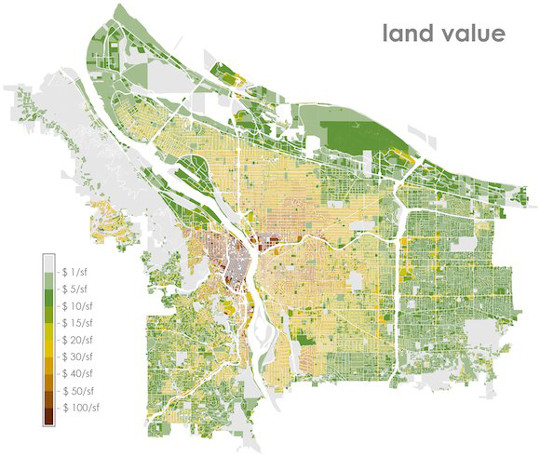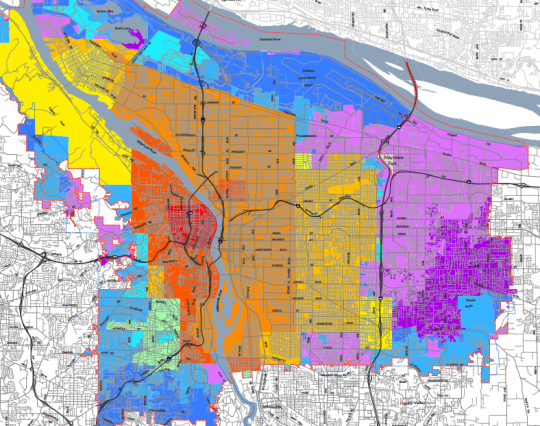
(All images except the last are © Fat Pencil Studio – click through to reach a larger version)
Money isn’t everything, and neither is land value.
But if you want to know how the world works, they’re both worth understanding. That’s why the above map, created as a policy exercise by our friend Joshua Cohen of the civic graphics firm Fat Pencil Studio, is so much fun.
It’s a color-coded map of the market value per acre of the land — not the buildings, just the land — beneath every tax lot in the City of Portland.
Cohen created the map last year as a way of calling attention to a problem he sees in city government: the fact that the public sets aside so much real estate in high-priced neighborhoods for the free storage of private cars.
“What we are giving up by continuing to stick with free parking for most of our city?” Cohen asked on his company’s blog. “As a city grows and evolves, the demands on the public right of way increase. We need to use it more effectively.”
But you don’t have to be a fervent parking reformer to find interesting details in Cohen’s map, the first I’ve seen of its kind for our city and one that would probably give land-value wonks like Chuck Marohn and Joe Minicozzi a lot to nod sagely over.
You should check out the full-size image on Fat Pencil Studio’s website, but here are five details I noticed.
1) The Northwest District is the most consistently valuable part of town where parking is still free.
Why are the Northwest 20s the worst place in Portland to find a parking space? Because land along those fun, beautiful streets is in extremely high demand but (unlike in downtown or the Lloyd District) if you happen to own a car, you can store it in the street for free for as long as you want.
This automotive socialism is finally going to change, at least a little, when parking permits start being required in the area this March. But at $60 a year, those permits won’t cover anywhere close to the actual value of renting a 130-square-foot tract of land that could theoretically sell for $8,000 on the open market — which is a pretty good sign that Northwest parking annoyances will be with us for a long time.
Advertisement
2) Southwest Portland isn’t worth much.
Three of Portland’s five city council members, and much of its ruling class, lives in Southwest Portland, our quadrant of winding roads and auto-oriented Anytown USA development (as well as plenty of neglected lower-income pockets). The wealth of many residents probably makes some people here think they’re sitting on the most economically important land in the city.
Nope. The mantlepieces might be fancy, but the dirt beneath them is a tax sink. Most of Southwest, and even a lot of the tony West Hills, is worth less than Mall 205 or the strip malls along North Lombard. And the value of Southwest’s land pales in comparison to spots like Old Town or the Lloyd Center — where you might meet someone who makes some rich folks uncomfortable but you’ll also see thousands of people conducting the business of city life every day.
3) Industrial areas aren’t exactly tax gushers.
Heavy industry can bring lots of good things to a city: exports, middle-class jobs, international transportation. But if you ever wanted an explanation for why cities are constantly rezoning industrial sanctuaries for other development, here’s why. Commercial and residential developers pay way, way more for land, because they can get more money out of it.
Side note: two of Portland’s biggest and most physically attractive factories produce a niche product — graduates. The University of Portland and Reed College have lovely grassy expanses that help convince smart people to pay lots of money to attend. But as long as their land is set aside for games of frisbee, it apparently isn’t worth much more per acre than a parking lot.
4) Cully and Brentwood-Darlington are low-cost enclaves.
There are only two big exceptions to the general rule that Portland’s most economically valuable land is the street grid between the West Hills and 82nd Avenue. The far southeast and northeast of that area have longer blocks, fewer sidewalks and far lower values per acre. In many ways, these are East Portland neighborhoods that just happen to be west of 82nd Avenue.
Why? The answer is in the final item…
5) Portland’s entire land value map is basically just another version of this other map.
What’s the second map? It’s a city record of which decade each part of Portland was annexed by the city — and therefore, generally speaking, how recently it was developed. The most valuable and economically important parts of town all fall in the red, orange and yellow areas, all of which joined the city of Portland before 1930.
In other words, the most valuable and economically important areas of town are also the ones that weren’t built to prioritize the rapid movement and free storage of private cars.
— The Real Estate Beat is a regular column. You can sign up to get an email of Real Estate Beat posts (and nothing else) here, or read past installments here. This sponsorship has opened up and we’re looking for our next partner. If interested, please call Jonathan at (503) 706-8804.
Update 1/23: Several readers felt that I went too far with the comments about Southwest Portland, and after thinking about it, I decided they’re right. I feel bad and I apologize. You can read more in the comments section.








